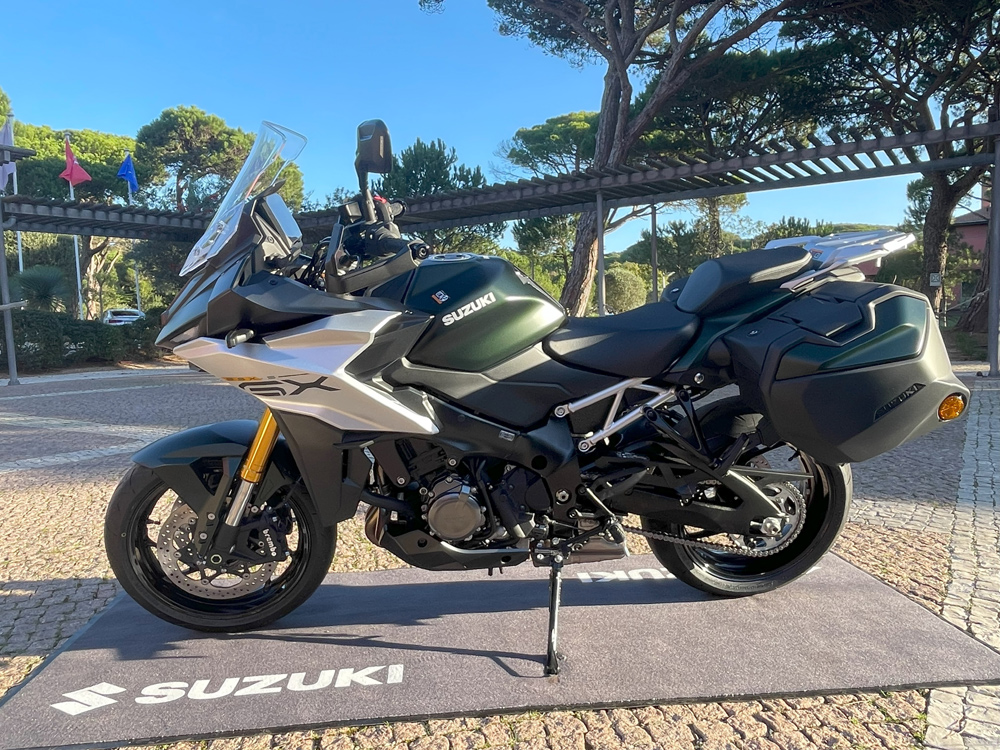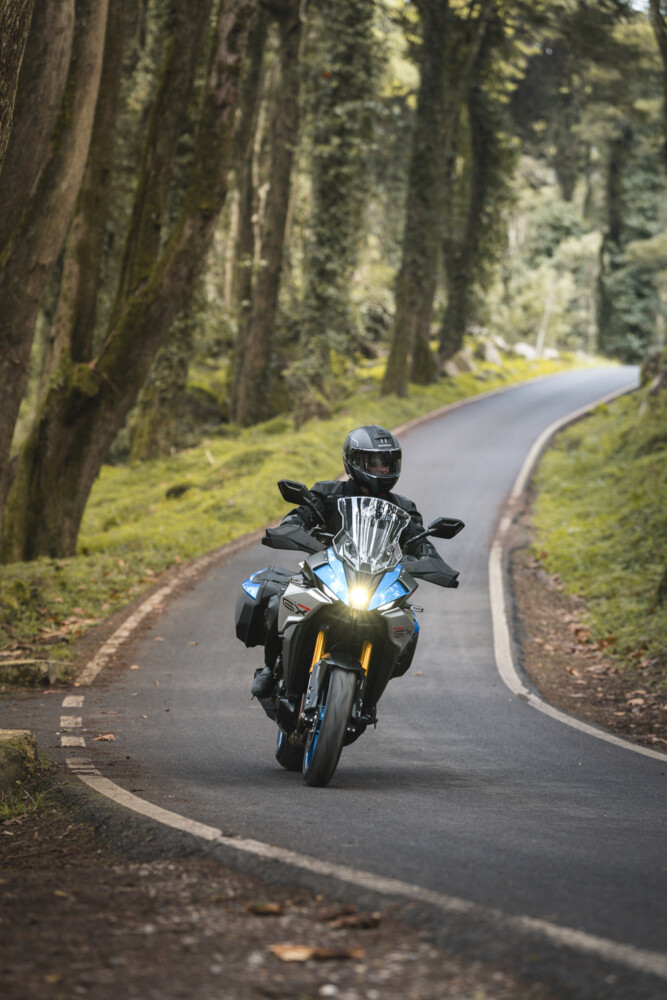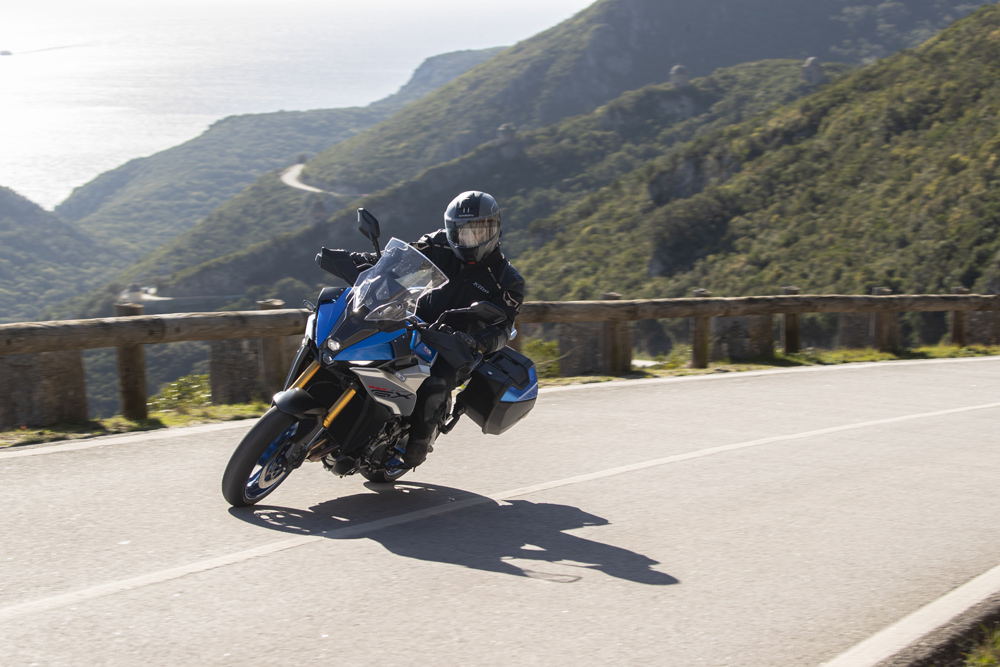| December 21, 2023
The crossover category is one of the smallest segments in the motorcycle industry. Still, it is growing, and like the currently exploding ADV segment, it’s only a matter of time before the masses discover these unique, very fun-to-ride models currently offered by only a few manufacturers.

By Keith Dowdle | Photography by Ula Serra, Amylee Photography
The upright seating position and taller suspension of crossover bikes allow for a wide rider triangle, which makes for a more comfortable riding position, like an adventure bike. Yet, the motors are typically high-performance powerhouses drawn from a sports bike somewhere else in the manufacturer’s lineup. The taller suspension puts you a little higher up for better visibility. It enables the bike to travel over more types of surfaces without dragging fairing parts. But these machines are thoroughbreds through and through, and they’re built to go fast but keep the rider comfortable enough for touring. All that holds true with the brand-new 2024 Suzuki GXS-S1000GX+, recently introduced to the global press in beautiful Cascais, Portugal.
“The Supreme Sport Crossover” is how the Suzuki engineers presenting the technical briefing describing this new model, and it is the most sophisticated motorcycle that Suzuki has ever produced. The fact that they brought at least 17 engineers to this launch also shows how vital this new model is to their lineup.
 The 2024 Suzuki GSX-S1000GX+ will be available in only the green colorway in the U.S.
The 2024 Suzuki GSX-S1000GX+ will be available in only the green colorway in the U.S.
With a full suite of electronics and a six-axis IMU incorporated into what’s called the Suzuki Intelligent Ride System, or S.I.R.S. (Japanese engineers love acronyms, so get ready for a lot of them), the GX+ is packed with every bell and whistle available on a modern motorcycle, except self-canceling turn signals. Okay, so they missed one or two things. Is that enough to remove it from their definition of “supreme”?
Powered by Suzuki’s legendary DOHC 999cc inline-four blasting out 152 horses, the motor is already considered by many to be supreme, as it draws on the heritage and architecture from one of the most successful engines Suzuki has ever built and which can be found in more than 180,000 units sold worldwide. Reliable and controllable power is what the Suzuki engineers say they wanted to achieve with this version of their famous motor configuration. With a full 70% of the available torque transferring to the ground in a very linear range from just 3000 rpm all the way up to a screaming 11,000 rpm, the motor is indeed the shining star in the GX+. That said, I did find it to be slightly buzzy at freeway speeds; however, with the various power settings from the Suzuki Drive Mode Select-alpha (really, that’s what they call it: SDMS-a), you do have options to choose how you want the power delivered. Some of that buzz can be mitigated by selecting a different power setting.
 When it comes to electronics, the GX+ is packed with every bell and whistle available on a modern motorcycle except, surprisingly, self-canceling turn signals.
When it comes to electronics, the GX+ is packed with every bell and whistle available on a modern motorcycle except, surprisingly, self-canceling turn signals.
Choosing between “A” (Active), “B” (Basic), or “C” (Comfort) settings changes not only the engine map but also the Smart TLR Control, which translates to “T” for traction control, “L” for lift/wheelie control, and “R” for Roll Torque Control. Changing between each of those modes makes a noticeable difference in the power delivery and the suspension, along with the amount of traction control at play. I found the Active mode too twitchy on initial throttle response and too stiff for something other than ultra-smooth roads. The Basic mode was the most comfortable for me, offering plenty of predictable power, a much smoother throttle delivery, a suspension setting that was acceptable on most surfaces, and just the right amount of traction control intervention.
 The GX+ is powered by Suzuki’s legendary DOHC 999cc inline-four, blasting out 152 horses.
The GX+ is powered by Suzuki’s legendary DOHC 999cc inline-four, blasting out 152 horses.
Comfort mode should be called “rain mode” because the power is cut to what feels like half of that available in Basic, and the suspension changes to something between Jekyll and Hyde, but you’ll be going slow anyway, so it shouldn’t matter that much. Fortunately, you can change the TC and suspension in each of the A, B and C modes to better suit what feels right to you. You can also change from active damping to whatever settings you like in the User mode, which I dug deep into trying to find suspension settings that suited my riding style. Finding your way through the various electronic settings is straightforward and easy to navigate on the well-designed 6.5-inch full-color display.
 Finding your way through the various electronic settings is straightforward and easy to navigate on the well-designed 6.5-inch full-color display.
Finding your way through the various electronic settings is straightforward and easy to navigate on the well-designed 6.5-inch full-color display.
As you’ve probably already figured out from the ride-mode descriptions above, another first for Suzuki on the GX+ is electronic suspension. Supplied by Showa but recalculated to become Suzuki Advanced Electronic Suspension, it’s constantly adjusting for everything from ride height by adjusting pre-load to speed, lean angle and road surface by adjusting compression and rebound damping. It even monitors front brake application and controls the amount of front suspension dive under heavy braking. They call this Suzuki Deceleration Damping Control (SDDC). Oh, and I can’t forget Suzuki Velocity Dependent Control (SVDC), which I already described in general. Enough acronyms for you yet? We’re not done.
While most electronic suspensions I’ve ridden on other brands tend to work well, I feel like Suzuki may have tried to over-engineer their first attempt at electronic suspension. In the two days of riding, and after digging deep into the user adjustments, I never could get the suspension on this bike to work the way I wanted. During the technical presentation, the engineers went into great detail regarding how much work they did and how many systems are present in this suspension. One of the many things they described is how “all three modes synchronize at 1 damping at very high speed.” They called it a Suzuki original and a breakthrough that their engineers discovered. Then they went into detail about what’s called Suzuki Floating Ride Control (SFRC), which creates a “skyhook effect,” but they stated that the system was too strong on smooth roads, so there was a need to counteract it with what is called Suzuki Road Adaptive Stabilization (SRAS) and how that too is a Suzuki exclusive program that automatically detects road surface conditions and switches the level of the SFRC effect. It all sounds way over-complicated to me, and I can’t help but think that has to do with why the suspension on the GX+ feels so different from other brands I’ve ridden. I’m not saying it’s not good, it just didn’t work for me, and I was never completely comfortable riding the bike aggressively. Hopefully, we’ll get an opportunity to do a long-term test away from the balls to the wall, riding like crazed lunatics in the atmosphere of a press intro. Perhaps the suspension will come to me in a more relaxed, sport-touring frame of mind.
 The windscreen is adjustable but, unfortunately, not easily.
The windscreen is adjustable but, unfortunately, not easily.
Let’s move on to some things that are less complicated and, thankfully, have no acronyms. I understand that beauty is in the eye of the beholder, but the aggressive styling of the GX+ works for me. I love the small pointy LED headlight and the way the fairing is shaped. According to the engineers, it wasn’t easy to get the fairing to work for stability at speed while still providing good wind protection for the rider; thus, they opted for a smaller windscreen than that found on the GT, and you can feel the effects when you’re on the freeway. We started with all the screens in the low position, but by the time we stopped for lunch, almost all of us asked for the windscreens to be raised to the high position. There are three positions available, but tools are needed to adjust the screen. Not sure why they didn’t make the windscreen adjustable on the fly, but they didn’t, and that’s a shame for a bike with an $18,499 MSRP. Once the screen was in the high position, the wind protection was better, but there was still a fair bit of buffeting. I’m 5′9″, and I felt it, so I’m sure that anyone taller would probably need to purchase an aftermarket screen to get a nice bubble from the wind.
 The GX+’s electronic suspension is extremely sophisticated, perhaps overly sophisticated? We need more time to figure it all out.
The GX+’s electronic suspension is extremely sophisticated, perhaps overly sophisticated? We need more time to figure it all out.
As I mentioned earlier, there is also a slight buzz from the motor on your feet at highway speeds. It’s not horrible, but it’s there. The Suzuki engineers were able to eliminate the buzz that was apparently an issue in the handlebars by installing rather large rubber grommets in the triple clamp where the handlebars are attached. However, the grommets are so large that there is a considerable amount of play in the bars. You don’t notice it that much when you’re riding, but if you give the bars a tug while stopped, you can feel movement. In terms of other rider-comfort features, the cruise control is very cool, and you can even change gears without canceling the cruise control. The bike is also equipped with a bidirectional quickshifter that works fantasticlly. Unfortunately, the same can’t be said about the stock seat, and after getting a chance to ride on the accessory seat, it’s worth every penny to invest in that. It looks better, and your bum will be much happier.
The GX+ comes with panniers and a centerstand—that’s what the plus (+) means—and you get handguards that do a nice job of keeping the wind off your hands. The cruise control, which, again, works well, is controlled by turning it on with your right thumb and setting, resuming, and increasing or decreasing speed with your left thumb. Your left thumb also controls all the electronics on the dash’s TFT screen, and I found it easy to use and very intuitive. You’ll also find Suzuki’s proprietary mySPIN connectivity app as you scroll through the menu, and of course, that allows you to connect your smartphone to display incoming phone calls, contacts, maps, and music. I didn’t try this feature, so unfortunately, I can’t tell you much about it. My apologies for that, but I was busy trying to get the suspension dialed.

The 2024 GSX-S1000GX+ is a very nice motorcycle. The fit and finish, quality of materials, and attention to detail are all very well executed, and personally, I love the looks of this bike. I do hope that we’ll get a chance to do a long-term review because two days weren’t enough time for me to get a full understanding of the capabilities of Suzuki’s new electronic suspension. That said, there are some basic but important features this bike is missing—like self-canceling turn signals and an on-the-fly-adjustable windscreen—that I have a hard time reconciling with a motorcycle that will be well over 20 grand by the time your purchase is complete.
With that, I’ll say that the Suzuki GSX-S1000 GX+ and I just didn’t gel as much as I had hoped, but that doesn’t mean it won’t work for you. It may very well be the most enjoyable bike you’ll ever ride.
Is it the supreme sport crossover machine? Only time will tell.CN
VIDEO | 2024 Suzuki GSX-S1000GX+

2024 Suzuki GSX-S1000GX+ Specifications
| MSRP: |
$18,499 |
| Engine: |
4-stroke, 4-cyclinder, inline |
| Valvetrain: |
DOHC, 16-valve |
| Displacement: |
999cc |
| Cooling system: |
Liquid |
| Compression Ratio: |
12.2:1 |
| Fuel system: |
FI w/Ride-by-Wire electronic throttle bodies |
| Lubrication: |
Wet sump |
| Transmission: |
6-speed w/quickshift system |
| Clutch: |
Wet, multi-plate, cable-actuated, Suzuki Clutch Assist System (SCAS) |
| Frame: |
Twin-spar, aluminum |
| Front Suspension: |
Telescopic fork, fully adjustable, Suzuki Advanced Electronic Suspension (SAES) |
| Rear Suspension: |
Single shock, fully adjustable, Suzuki Advanced Electronic Suspension (SAES) |
| Front-wheel travel: |
5.9 in. |
| Rear-wheel travel: |
5.9 in. |
| Front wheel: |
120/70ZR-17 in., Dunlop Roadsport 2 tire |
| Rear wheel: |
190/50ZR-17 in., Dunlop Roadsport 2 tire |
| Front brake: |
Brembo, radially mounted 4-piston calipers, dual 310mm disc, ABS-equipped. |
| Rear brake: |
>Nissin, 1-piston, single disc, ABS-equipped |
| Seat height: |
33.3 in. |
| Wheelbase: |
57.9 in. |
| Ground clearance: |
6.1 in. |
| Fuel capacity: |
5.0 gal. |
| Weight (curb): |
511 lbs. |
| Color: |
Pearl Matte Shadow Green |
